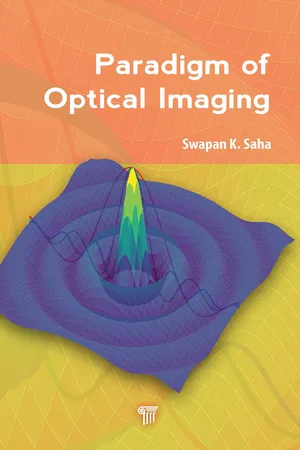
- English
- ePUB (mobile friendly)
- Available on iOS & Android
eBook - ePub
Paradigm of Optical Imaging
About this book
This book deals with various aspects of optical imaging such as technologies and design, evaluation and calibration, and their scientific applications and results. It discusses the fundamental aspects of optical imaging, Fourier optics, and imaging physics with emphasis on image retrieval techniques and anatomy and diagnostics of optical imaging systems. In addition to ray optics, the book describes the technical details of several important instruments, such as spectroscopes, microscopes, telescopes, interferometers, and medical diagnosis–related instruments. Added further are the factors that affect the quality of the images, speckles and holography, and passive and active methods that permit a telescope to achieve diffraction-limited imaging from the ground. The book will be a valuable resource for astronomers and students involved in the design of modern instrumentation or those attempting to make use of data with instrumentation designed by others.
Frequently asked questions
Yes, you can cancel anytime from the Subscription tab in your account settings on the Perlego website. Your subscription will stay active until the end of your current billing period. Learn how to cancel your subscription.
At the moment all of our mobile-responsive ePub books are available to download via the app. Most of our PDFs are also available to download and we're working on making the final remaining ones downloadable now. Learn more here.
Perlego offers two plans: Essential and Complete
- Essential is ideal for learners and professionals who enjoy exploring a wide range of subjects. Access the Essential Library with 800,000+ trusted titles and best-sellers across business, personal growth, and the humanities. Includes unlimited reading time and Standard Read Aloud voice.
- Complete: Perfect for advanced learners and researchers needing full, unrestricted access. Unlock 1.4M+ books across hundreds of subjects, including academic and specialized titles. The Complete Plan also includes advanced features like Premium Read Aloud and Research Assistant.
We are an online textbook subscription service, where you can get access to an entire online library for less than the price of a single book per month. With over 1 million books across 1000+ topics, we’ve got you covered! Learn more here.
Look out for the read-aloud symbol on your next book to see if you can listen to it. The read-aloud tool reads text aloud for you, highlighting the text as it is being read. You can pause it, speed it up and slow it down. Learn more here.
Yes! You can use the Perlego app on both iOS or Android devices to read anytime, anywhere — even offline. Perfect for commutes or when you’re on the go.
Please note we cannot support devices running on iOS 13 and Android 7 or earlier. Learn more about using the app.
Please note we cannot support devices running on iOS 13 and Android 7 or earlier. Learn more about using the app.
Yes, you can access Paradigm of Optical Imaging by Swapan K. Saha in PDF and/or ePUB format, as well as other popular books in Technology & Engineering & Astronomy & Astrophysics. We have over one million books available in our catalogue for you to explore.
Information
Table of contents
- Cover Page
- Half Title page
- Title Page
- Copyright Page
- Dedication
- Contents
- Preface
- Acknowledgement
- Principal Symbols
- Greek Symbols
- Some Numerical Values of Physical and Astronomical Constants
- List of Acronyms
- 1 Fundamentals of Optical Imaging
- 2 Fourier Analysis
- 3 Imaging Physics
- 4 Anatomy and Diagnostics of Optical Imaging Systems
- 5 Imaging Instruments for Astronomical Applications
- 6 Imaging Techniques for Medical Applications
- 7 Factors Affecting Image Quality
- 8 Speckles and Holography
- 9 Retrieval of Turbulence-Affected Images
- Appendix A: Typical Function Definitions
- Appendix B: Correlation Methods
- Appendix C: Interference between Radiation Sources
- Appendix D: Principles of Emissions
- Bibliography
- Index